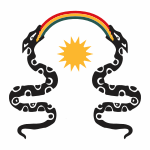Related Research Articles

The Inca Empire, called Tawantinsuyu by its subjects, was the largest empire in pre-Columbian America. The administrative, political, and military center of the empire was in the city of Cusco. The Inca civilization rose from the Peruvian highlands sometime in the early 13th century. The Spanish began the conquest of the Inca Empire in 1532 and by 1572, the last Inca state was fully conquered.

Puno is a department and region in southeastern Peru. It is the fifth largest department in Peru, after Cuzco, Madre de Dios, Ucayali, and Loreto. It is bordered by Bolivia on the east, the departments of Madre de Dios on the north, Cusco and Arequipa on the west, Moquegua on the southwest, and Tacna on the south. Its capital is the city of Puno, which is located on Lake Titicaca in the geographical region known as the Altiplano or high sierra.
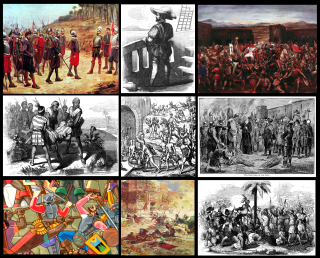
The Spanish conquest of the Inca Empire, also known as the Conquest of Peru, was one of the most important campaigns in the Spanish colonization of the Americas. After years of preliminary exploration and military skirmishes, 168 Spanish soldiers under conquistador Francisco Pizarro, along with his brothers in arms and their indigenous allies, captured the Sapa Inca Atahualpa in the 1532 Battle of Cajamarca. It was the first step in a long campaign that took decades of fighting but ended in Spanish victory in 1572 and colonization of the region as the Viceroyalty of Peru. The conquest of the Inca Empire, led to spin-off campaigns into present-day Chile and Colombia, as well as expeditions to the Amazon Basin and surrounding rainforest.
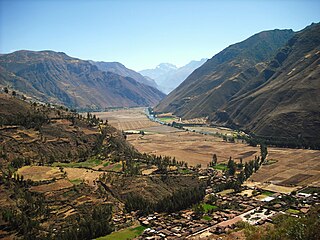
The Sacred Valley of the Incas, or the Urubamba Valley, is a valley in the Andes of Peru, north of the Inca capital of Cusco. It is located in the present-day Peruvian region of Cusco. In colonial documents it was referred to as the "Valley of Yucay." The Sacred Valley was incorporated slowly into the incipient Inca Empire during the period from 1000 to 1400.
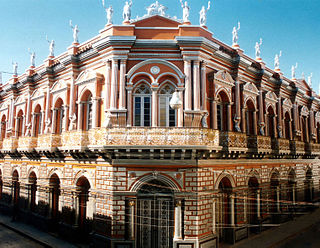
Tarija or San Bernardo de la Frontera de Tarixa is a city in southern Bolivia. Founded in 1574, Tarija is the largest city and capital and municipality within the Tarija Department, with an airport offering regular service to primary Bolivian cities, as well as a regional bus terminal with domestic and international connections. Its climate is semi-arid (BSh) with generally mild temperatures in contrast to the harsh cold of the Altiplano and the year-round humid heat of the Amazon Basin. Tarija has a population of 234,442.
Mit'a was mandatory service in the society of the Inca Empire. Its close relative, the regionally mandatory Minka is still in use in Quechua communities today and known as faena in Spanish.
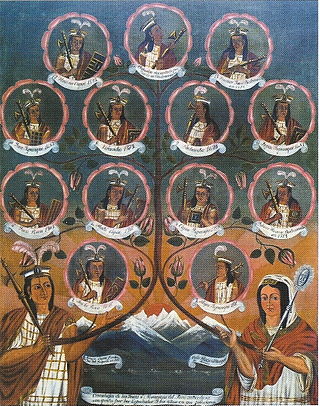
The Incas were most notable for establishing the Inca Empire which was centered in modern-day South America in Peru and Chile. It was about 2,500 miles from the northern to southern tip. The Inca Empire lasted from 1438 to 1533. It was the largest Empire in America throughout the Pre-Columbian era. At the peak of the Inca Empire, it was the largest nation in the world and to this day is the largest native state in the western hemisphere. The Inca civilization was located from north to south of the western hemisphere of South America. The Inca state was known as the Kingdom of Cuzco before 1438. Over the course of the Inca Empire, the Inca used conquest and peaceful assimilation to incorporate the territory of modern-day Peru, followed by a large portion of western South America, into their empire, centered on the Andean mountain range. However, shortly after the Inca Civil War, the last Sapa Inca (emperor) of the Inca Empire was captured and killed on the orders of the conquistador Francisco Pizarro, marking the beginning of Spanish rule. The remnants of the empire retreated to the remote jungles of Vilcabamba and established the small Neo-Inca State, which was conquered by the Spanish in 1572.
The High Academy of the Quechua Language, or AMLQ, is a Peruvian organization dedicated to the teaching, promotion, and dissemination of the Quechua language.

A tambo was an Inca structure built for administrative and military purposes. Found along the extensive roads, tambos typically contained supplies, served as lodging for itinerant state personnel, and were depositories of quipu-based accounting records. Individuals from nearby communities within the Inca empire were conscripted to maintain and serve in the tambos, as part of the mit'a labor system. Tambos were spaced along Inca roads, generally about one day's travel apart.

The Inca army was the multi-ethnic armed forces used by the Tawantin Suyu to expand its empire and defend the sovereignty of the Sapa Inca in its territory.
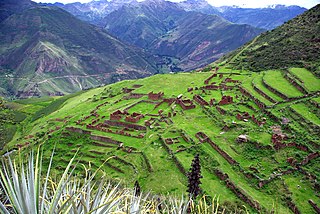
Huchuy Qosqo,, is an Incan archaeological site north of Cuzco, Peru. Its name is Quechua for "Little Cuzco." It lies at an elevation of 3,650 meters, overlooking the Sacred Valley and 3 kilometres (1.9 mi) west and above the town of Lamay at an elevation of 2,920 metres (9,580 ft). The site received its name in the 20th century; previously it had been known as Caquia Xaquixaguana, or Kakya Qawani.

A qullqa (Quechua pronunciation:[ˈqʊʎˌqa] "deposit, storehouse"; was a storage building found along roads and near the cities and political centers of the Inca Empire. These were large stone buildings with roofs thatched with "ichu" grass, or what is known as Peruvian feathergrass. To a "prodigious [extent] unprecedented in the annals of world prehistory" the Incas stored food and other commodities which could be distributed to their armies, officials, conscripted laborers, and, in times of need, to the populace. The uncertainty of agriculture at the high altitudes which comprised most of the Inca Empire was among the factors which probably stimulated the construction of large numbers of qullqas.

The Lupaca, Lupaka, or Lupaqa people were one of the divisions of the ancestral Aymaras. The Lupaca lived for many centuries near Lake Titicaca in Peru and their lands possibly extended into Bolivia. The Lupacas and other Aymara peoples formed powerful kingdoms after the collapse of the Tiwanaku Empire in the 11th century. In the mid 15th century they were conquered by the Inca Empire and in the 1530s came under the control of the Spanish Empire.

The Andean civilizations were South American complex societies of many indigenous people. They stretched down the spine of the Andes for 4,000 km (2,500 mi) from southern Colombia, to Ecuador and Peru, including the deserts of coastal Peru, to north Chile and northwest Argentina. Archaeologists believe that Andean civilizations first developed on the narrow coastal plain of the Pacific Ocean. The Caral or Norte Chico civilization of coastal Peru is the oldest known civilization in the Americas, dating back to 3500 BCE. Andean civilization is one of the six "pristine" civilizations of the world, created independently and without influence by other civilizations.
The Tawantinsuyu or Inca Empire was a centralized bureaucracy. It drew upon the administrative forms and practices of previous Andean civilizations such as the Wari Empire and Tiwanaku, and had in common certain practices with its contemporary rivals, notably the Chimor. These institutions and practices were understood, articulated, and elaborated through Andean cosmology and thought. Following the Spanish conquest of the Inca Empire, certain aspects of these institutions and practices were continued.

Inca rule in Chile was brief, it lasted from the 1470s to the 1530s when the Inca Empire was absorbed by Spain. The main settlements of the Inca Empire in Chile lay along the Aconcagua, Mapocho and Maipo rivers. Quillota in Aconcagua Valley was likely the Incas' foremost settlement. The bulk of the people conquered by the Incas in Central Chile were Diaguitas and part of the Promaucae. Incas appear to have distinguished between a "province of Chile" and a "province of Copayapo" neighboring it to the north. In Aconcagua Valley the Incas settled people from the areas of Arequipa and possibly also the Lake Titicaca.

Pre-Columbian Bolivia covers the historical period between 10,000 BCE, when the Upper Andes region was first populated and 1532, when Spanish conquistadors invaded Inca empire. The Andes region of Pre-Columbian South America was dominated by the Tiwanaku civilization until about 1200, when the regional kingdoms of the Aymara emerged as the most powerful of the ethnic groups living in the densely populated region surrounding Lake Titicaca. Power struggles continued until 1450, when the Incas incorporated upper Bolivia into their growing empire. Based in present-day Peru, the Incas instituted agricultural and mining practices that rivaled those put in place many years later by European conquerors. They also established a strong military force, and centralized political power. Despite their best efforts however, the Incas never completely controlled the nomadic tribes of the Bolivian lowlands, nor did they fully assimilate the Aymara kingdoms into their society. These internal divisions doomed the Inca Empire when European conquerors arrived.
Quispiguanca, also Q'espihuanca and Q'espiwanka, was a royal estate of the Inca emperor Huayna Capac. The ruins of the estate are located in the northern part of the present-day town of Urubamba, Peru at an elevation of 2,910 metres (9,550 ft).

The Saraguro is a people of the Kichwa nation most of whom live in Saraguro Canton in the Loja Province of Ecuador. Although most now speak Spanish, Runashimi or Kichwa, a Quechua dialect, is also spoken and language revitalization efforts are being implemented. Likewise, the Saraguro have retained much of their land, customs and traditional dress. According to the INEC's 2010 population census, the total population of Saraguro canton is 30,183, but that total includes both the Indigenous and non-Indigenous people living in Saraguro.

Tala Canta Ilabe was an Inca governor for a zone in Collasuyo, corresponding to the ayllu where Talagante is currently located, near Santiago de Chile. Quilicanta, the Inca governor of Collasuyo who was assassinated by Inés de Suárez, was also from the same panaka as Tala Canta IIabe.
References
- ↑ (in Spanish) Topónimos del Quechua Yungay Archived 2009-02-13 at the Wayback Machine . Retrieved on November 29, 2007.
- ↑ de Freitas 2009, 154
- ↑ Mannheim 1991, 92
- ↑ Terence D'Altroy 2003, p.248.
- ↑ D'Altroy 2003, 231
- ↑ de Freitas 2009, 154
- ↑ Moseley 1992, 10
- ↑ de Freitas 2009, 154
- ↑ D'Altroy 2003, 231
- ↑ D'Altroy 2003, 236
- ↑ de Freitas 2009, 154
- ↑ D'Altroy 2003, 236
- ↑ Covey 2000, 120
- ↑ Patterson 1987, 123
- ↑ Patterson 1987, 123
- ↑ Patterson 1987, 118
- ↑ Pease 1981, 247
- ↑ Patterson 1987, 118
- ↑ Covey 2000, 122
- ↑ Patterson 1987, 119
- ↑ Patterson 1987, 123
- ↑ Patterson 1987, 119
- 1 2 3 Patiño, Roberto (January 20, 2019). "Churumatas y tomatas, la conexión chilena en Tarija". El País (in Spanish). Retrieved January 20, 2020.
- ↑ Cortés Larravide, Enrique (2016). "¿Existió un grupo llamado Copiapó en el valle homónimo? Reflexiones a partir de los testimonios coloniales". Revista Tiempo Histórico (in Spanish). 7 (12): 17–32.
